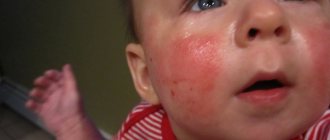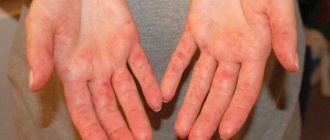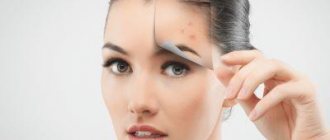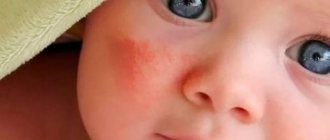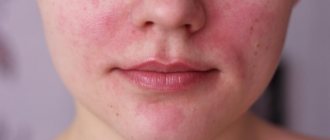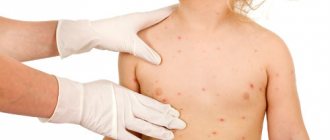Causes of rashes, pimples and spots on elbows
Such an unpleasant circumstance, when a child has itchy red pimples on his elbows and knees, indicates both a simple cause of skin irritation and a serious illness. The culprit when red spots appear on the elbows and itch may be more than one disease:
- atopic dermatitis . It appears as a result of contact with various allergy-provoking substances that are contained in hygiene products, clothing, animal hair, and pollen of flowering plants. As well as the body’s response to the consequences of contact with household chemicals, medicines and food. Accompanied by redness and severe itching;
- eczema _ This disease is characterized by the appearance under the epidermis of a large number of small blisters filled with liquid. By scratching such blisters, you can damage the inflamed areas of the skin of the elbow, as well as the knee, and cause a dangerous infection;
- mycosis . Refers to a fungal infection in which the skin becomes covered with a small rash, forming oval-shaped spots that turn white over time. Especially in those parts of the body where increased sweat production occurs. These are the armpits, groin, knees, feet, between the toes, elbow bends;
- Psoriasis is one of the most difficult diseases that is almost impossible to cure completely. The skin on the elbow turns red, becomes covered with a rash, which is not very noticeable at the beginning of the disease, and constantly peels off with characteristic grayish scales. If you do not resort to treatment in time, the rash may spread to unaffected areas of the skin;
- scabies , which is caused by the presence of a parasite such as the scabies mite. As a result, the thin skin in the elbow area may be affected and covered with red spots that are very itchy;
- Various reasons for the appearance of a rash can be diseases of internal organs, hormonal imbalance, weakened immunity, prolonged stress, basic lack of hygiene or abuse of cosmetics .
Why does a child have an allergy in the crook of the elbow and how to treat it?
In children and adults, the skin around the knees and elbows is thinner, more sensitive and dry than in other places. For this reason, it is more likely to cause irritation and allergic reactions. The appearance of itching, redness, and swelling may develop due to hypersensitization of the body. Therefore, allergies in the crook of the elbow in a child require a special approach to treatment.
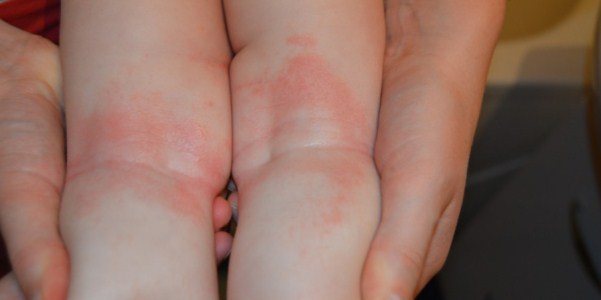
How to distinguish an allergic rash from other diseases
It is very difficult to independently distinguish an allergic rash from other diseases . When a child develops spots on his elbows that are red and flaky, as well as on the inside of his knees, there may be several reasons. The appearance of a rash on the body of an adult in the elbow area, which itches and itches, also requires determining a treatment method. Such manifestations are signs of a wide variety of diseases:
- with an infectious disease such as rubella , an enlargement of the lymph nodes is observed, which makes this sign especially distinctive. Heat. The spread of the rash occurs differently than with allergies. Rashes begin to cover the face, and then the whole body;
- a serious illness, measles , which is accompanied by a dry cough and hoarseness, severe headache and throat pain, and fever. But the rash appears only on the third or fourth day and first covers the face, neck, stomach and then the whole body;
- Scarlet fever is characterized by the presence of a rash consisting of small papules. There is also abundant peeling on the palms and soles. The rash may disappear quickly, but the epidermis from the affected areas peels off greatly;
- if the rash is caused by fungal microflora , then it will be distinguished from an allergic rash by the localization of the papules. They appear on areas of the body with hair, as well as between the fingers and toes. Typically, redness of a localized area of the body is accompanied by peeling and further spreads in the form of rings;
- with lichen, pink scaly spots are characteristic, which have clear outlines, in contrast to a vague allergic-type rash;
- For psoriasis, a distinctive feature from an allergic rash is the presence of bright red plaques. They come in different shapes and sizes. There are silvery scales on their surface. The rash usually appears on the head, elbows, lower back and knees.
CAUTION: Without knowing why the rashes appeared, you should not resort to any treatment methods.
Features of therapy in children
Treatment of a child with an allergic rash on the bends of the elbows should also begin with the exclusion of the allergen. Unlike an adult, a baby’s immunity is in its infancy; only by the age of three is it considered fully developed. Therefore, it is not always possible to detect a substance or food product that causes pathological irritation through laboratory testing.
New complementary feeding products and skin care cosmetics are the first to come under suspicion. If a child drinks mother's milk, then the woman should exclude baked goods, dairy products, chocolate and coffee from her diet to prevent another rash. The children's room must be wet cleaned daily.
If an older child eats from a common table, then it is necessary to introduce a hypoallergenic diet with the exclusion of products containing cocoa, sweets, red berries and vegetables . Along with the diet, you can give sorbents that will remove substances that cause allergies. It is best to use Smecta or Polysorb.
Types of rash
The types of rashes for various diseases differ in the nature of localization, color, shape, etc.
Rashes on the outside
Small pimples on the outside of the elbows can be characteristic of such common diseases as atopic dermatitis and eczema. The skin is very itchy; as a result of mechanical damage, microcracks form, which turn into an itchy rash in the form of blisters and hives. You can learn more about urticaria in the video.
Causes
The cause may be contact with toxic substances or the body's response to food allergens. Less commonly, the cause of rashes on the outside of the elbow is a fungal disease, mycosis.
Treatment
The peculiarity of the treatment is that a set of measures is necessary, since the outer side of the elbow is an area of increased skin trauma. Treatment may consist of antibiotics, ointments and various lotions.
ATTENTION: The course of treatment can only be prescribed by a specialist!
Rash on the elbows
Most often, a rash on the bend of the elbow can be a manifestation of an allergy. With psoriasis, scabies, and also with a lack of vitamins, rashes are also observed.
Causes
Since the skin on the bend of the elbow is thin and sensitive, an allergic reaction to contact with cosmetics and perfumes, clothing, dust, and animals often occurs here.
Treatment
Despite the effectiveness of treatment with ointments based on glucocorticosteroids, the use of these products without a doctor’s prescription is contraindicated! This is due to the fact that they suppress the inflammatory process and if the infection joins the allergy, it may spread.
White rashes
The main factor behind white rashes on the elbows is mechanical friction against some surface.
Causes
From sedentary work, when the elbows are located most of the time on the table. Due to the mechanical friction of the skin against the object, microscopic cracks are formed, where dirt can get in, and with it microbes that can cause inflammation. Allergic dermatitis or eczema may also be the cause. The white rash on the elbows is itchy and can spread to other areas of the body.
Treatment
Treatment is possible only after consultation with a dermatologist, who will prescribe the main course. Traditional medicine can provide additional assistance in the fight against this disease.
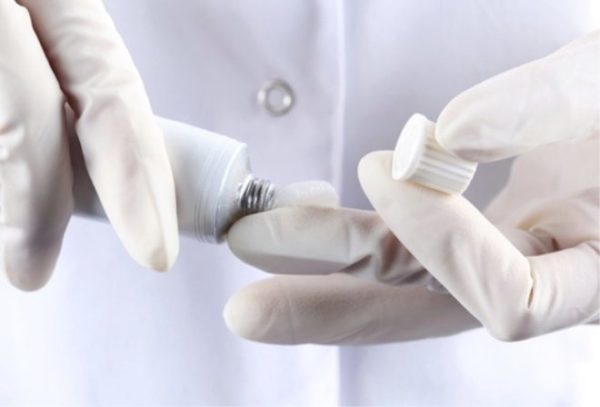
Rash on the elbows of a child
The most common reason why a rash appears on a child’s elbows, as well as on the bend of the knee, is an allergy. Signs of the disease may be a small red spot, a pimple, or a single pimple. Rashes in the form of numerous pimples begin to itch, which causes redness of the skin. In this case, you should not hesitate to identify the allergen, so as not to trigger the disease. In children, just like in adults, small pimples on the elbows may appear and itch from the bite of small insects.
There are also specific factors for such rashes:
- Granuloma annulare disease affects children under six years of age in most cases. The rashes are dense formations that resemble pink-red rings in appearance;
- A rash on the elbows can also appear due to hormonal imbalance;
- fairly common causes of the rash are rubella or contact dermatitis.
What diseases cause red spots to appear on a child’s body?
Spotted rash in children
Have you been struggling with ALLERGY for many years without success?
Head of the Institute: “You will be amazed at how easy it is to cure allergies just by taking it every day...
Read more "
Spots on the skin of a child are a clinical symptom that is possible at any age. The following causes of body rash in babies are known:
- allergic reactions;
- atopic form of dermatitis;
- measles;
- rubella;
- Infectious mononucleosis;
- insect and tick bites;
- erythema;
- chicken pox;
- Henoch-Schönlein disease;
- eczema;
- hives;
- burns;
- side effects of medications;
- furuncle;
- erysipelas;
- thrombocytopenic purpura;
- toxicoderma.
Often the rash peels off. Any area of the body is affected, including the face. Large red spots may be accompanied by pain, burning, irregular dermographism, fever, swollen lymph nodes and other symptoms. Often, a rash appears on the body in HIV-infected children.
Henoch-Schönlein purpura
The skin in childhood may become covered with red spots due to hemorrhagic vasculitis. This pathology is known as Henoch-Schönlein disease. This condition belongs to the group of systemic vasculitis. Henoch-Schönlein purpura primarily affects the capillaries. Often the kidneys and joints are involved in the process.
Children aged 5-14 years are affected. The prevalence of vasculitis is 0.2%. Spots on a child's skin are caused by several factors. The most common reasons are:
- herpes;
- ARVI;
- flu;
- mycoplasmosis;
- tuberculosis;
- food poisoning;
- administration of vaccines;
- food allergies;
- hypothermia.
The appearance of red spots on the skin of a child is a consequence of damage to the microvasculature and the formation of immune complexes. The latter are deposited on the vascular endothelium and cause an aseptic inflammatory process. Venules, arterioles and capillaries are involved in the process. Microthrombosis forms on their walls. Spots on the child’s body are a component of the hemorrhagic syndrome of this disease.
This is a constant symptom that occurs at the very beginning. The rash is maculopapular. The spots do not disappear with pressure. Less commonly, blisters appear on the skin. The elements of the rash in hemorrhagic vasculitis are small. They are localized in the hips, buttocks, large joints, arms and torso. The spots are located symmetrically.
In severe cases, ulcers may appear. After the rash disappears, the area of skin turns red. The chronic course of the disease can cause peeling. Redness on a child's skin is not the only symptom. Along with the rash, joint pain, limited mobility, abdominal pain and fever are observed. Damage to the blood vessels of the heart, kidneys and brain is possible with the development of dangerous complications.
Allergic dermatitis
Red spots may appear in a child against the background of atopic (allergic) dermatitis. This is a genetic pathology associated with increased sensitivity of children to the effects of various substances. The allergens are:
- Food;
- helminths;
- vaccines;
- medicines;
- chemicals;
- household chemicals;
- low temperature;
- pollen;
- insect waste products;
- nutritional supplements.
The most common cause is the entry of foreign proteins into the body. The appearance of a rash in atopic dermatitis is based on the following processes:
- release of immunoglobulin E;
- release of histamine and serotonin;
- infiltration.
At first, certain areas of the body turn red. The reason is the expansion of capillaries to accelerate the entry of immune cells. Then a rash appears. Most often it is represented by red spots of irregular shape. Less commonly, papules, vesicles or pustules appear. Favorite places to localize spots are cheeks, folds, scalp, folds of arms and legs.
The affected skin itches. Against the background of itching, infection may occur. Additional signs of atopic dermatitis are dry skin, lichenification, irritability, sleep disturbances and restlessness. Spots most often appear in the acute form of the disease. The rash occurs upon repeated contact with the allergen. Often the mucous membranes are involved in the process.
Manifestations of urticaria
Red spots on a child’s arm are a sign of urticaria. This is not an independent disease, but a manifestation of an allergic reaction. Urticaria develops against the background of shock, asthma, dermatitis and other pathologies. The reasons for its occurrence are:
- exposure to sunlight;
- insect bites;
- sting;
- cold;
- exposure to vibration;
- mechanical friction of skin on clothing;
- household allergens (dust, insects);
- autoimmune diseases.
Sometimes a rash occurs with diabetes. Exanthema has the following distinctive features:
- appears immediately or several hours after contact with the allergen;
- accompanied by intense itching;
- represented by pink spots and blisters;
- localized mainly on the trunk, upper limbs and buttocks;
- often accompanied by a deterioration in the general condition of the child;
- prone to fusion.
Solar urticaria affects exposed areas of the body. The chronic form of this pathology can drag on for several years. In children, it most often lasts 1-2 days. Complications of urticaria include angioedema, suppuration and depression. Once the spots and blisters disappear, no scars form on the skin.
Infectious mononucleosis
The child's body becomes covered with spots due to infectious mononucleosis. This is a pathology caused by the Epstein-Barr virus. Children under 10 years of age are most often affected. Infection is possible through contact with a source of infection. The virus is found in saliva and is transmitted by coughing, talking or sneezing. It may take up to 2 weeks for the rash to appear.
In the early stages of mononucleosis, the child's body becomes covered with a rash. Exanthema has the following features:
- appears simultaneously with fever and swollen lymph nodes;
- doesn't itch;
- represented by small pink and red spots;
- does not require treatment;
- affects the chest, abdomen, legs, arms and face.
If itching occurs, this may indicate an allergy to medications. The rash in infectious mononucleosis is combined with lymphadenopathy, sweating, chills, fever, tonsil damage, enlarged liver and spleen. Complications of the disease include meningoencephalitis, lung damage, thrombocytopenia and hepatitis. Getting rid of the Epstein-Barr virus is very difficult. It can live in the body for many years.
Exanthema with rubella
The appearance of a spot or a profuse rash on the body may indicate the development of rubella in a child. This is a viral pathology, most often occurring in a mild form. Rubella is accompanied by a rash, fever and swollen lymph nodes. The peculiarity of this disease is that it often leads to outbreaks. They occur every 6-9 years.
The incubation period is 2-3 weeks. The following symptoms are possible with this disease:
- exanthema;
- general malaise;
- mild fever;
- runny nose;
- redness of the eyes;
- hyperemia of the pharynx;
- enlarged lymph nodes.
The rash is an early symptom of rubella. Parts of the body are covered with red spots. Their diameter is 5-7 mm. Exanthema appears on smooth skin. The process involves the buttocks, elbow and popliteal fossae, face, lower back, and upper back. The peculiarity of the rash is that it spreads from top to bottom. After 2-3 days, the spots disappear.
In some children, areas of the body are covered with large spots up to 10 cm in size. Sometimes they have scalloped edges. Elements of the rash do not rise above the skin. Papules are less likely to form. In many patients, the rash is poorly visible. She's pale. In some cases, rubella affects the mucous membrane of the palate.
Manifestations of deprivation
If an area of your child's skin is covered in spots, the cause may be lichen. This is a collective concept that includes various skin diseases with rashes and severe itching. In most cases, the cause is a fungal infection. The following types of lichen are known:
- pityriasis;
- red flat;
- pink;
- trichophytosis.
In children over 10 years of age, pityriasis rosea is often diagnosed. This disease tends to heal spontaneously. The causative agent has not been identified. Often, a rash appears after a cold. With Zhiber's lichen, the child develops 1 large yellowish-pink spot. This is the mother's plaque. Peeling of the skin is typical. After some time, the elements of the rash become like medallions.
They are pale in the center, and the pink color remains at the edges. Over time, smaller, red, scaly patches form on the body. In every fourth patient, the rash is accompanied by intense itching. The spots persist for a month. The focus of the rash in pityriasis rosea is most often 1. Less often, several areas are affected at once.
Not only a small child, but also a teenager can suffer from the rash. Sometimes the cause of exanthema is pityriasis versicolor. This is a fungal disease. With it, multiple round spots about 1 cm in size appear. They increase in size. A distinctive feature of this pathology is the presence of spots of different colors on the body (dark brown, brown, pink, yellow). The elements of the rash are scaly. Pain, itching and burning are most often not a concern.
Other causes of rashes
Redness of the skin in a child is a sign of erysipelas. During the height of the disease, a large red spot appears on the body. It has jagged edges. Signs of inflammation are clearly expressed. Sometimes the spot turns brown. When you press on the skin, it disappears for 1-2 seconds. With the erythematous-hemorrhagic form, hemorrhages occur.
After the spot disappears, slight peeling is observed and pigmentation remains. In most cases, the elements of the rash do not itch. Reddened areas of the skin may indicate the onset of chickenpox. Almost all children suffer from this disease. Small spots appear first. They are located chaotically. Gradually they turn into papules and vesicles. After drying, crusts form. Children are bothered by intense itching, especially at night.
Examination and treatment tactics
If your child has red spots, you should consult a doctor. The following studies will be needed:
- general clinical tests;
- coagulogram;
- serological analysis;
- scraping examination;
- dermatoscopy;
- examination using a Wood's lamp;
- fecal analysis for helminths;
- determination of antinuclear antibodies in the blood;
- provocative tests;
- skin tests;
- immunological study.
The appearance of the rash is often preceded by a prodromal period, so it is important to interview the child and parents about the development of the disease. Therapeutic tactics depend on the main cause of the appearance of red spots. For atopic dermatitis, local remedies are used in the form of ointments and creams, NSAIDs, glucocorticoids, and antihistamines. Medicines such as Triderm and Akriderm have proven themselves well.
If your skin is dry, you need to use moisturizers. It is important to eliminate exposure to allergens. With infectious mononucleosis, the rash does not require treatment. It disappears on its own and is not dangerous. Antipyretics, immunomodulators, and antiseptics are prescribed. If you have rubella, you need to stay in bed.
Glucocorticoids and anti-inflammatory drugs are prescribed. If hemorrhagic vasculitis is detected, sick children are prescribed heparin-based anticoagulants. In severe cases, blood purification is required. Thus, the appearance of red spots on a child’s body is a reason to visit a pediatrician.
Complications
To avoid complications, it is recommended to begin treatment with a consultation with a qualified specialist, be it a therapist, dermatologist or allergist.
Only a doctor can determine the reason why redness appears in the elbow area or the skin is covered with blisters. Any rash, in the form of hives, a vesicle or spot that turns red and peels, can be symptoms of various diseases. Typically, redness of the skin is accompanied by severe itching and scratching should never be allowed, as irritation may increase.
It is known that in most cases, a rash on the elbows is not contagious, but still, if professional help is neglected, the side effects from improper treatment can have serious consequences.
If you independently treat an infectious disease as an allergy, then the spread of infection throughout the body will not be long in coming.
Of course, the symptoms of such diseases vary, but at the first appearance of suspicious rashes, you need to promptly consult a doctor to determine an accurate diagnosis. The disease is easier to cure at the initial stage.
General rules and methods of treatment
Before starting treatment, you need to see a doctor to undergo a full examination and make an accurate diagnosis.
The general principles of therapy are to identify the allergen and eliminate contact with it. When the rashes occupy a large area and are accompanied by severe itching and discomfort, it is best to consult a doctor immediately. In the absence of proper treatment, allergies in children can also appear on the face, as in the photo below.
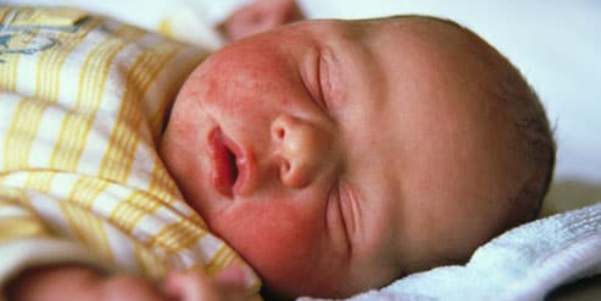
The treatment regimen for such deviations consists of taking antihistamines, which suppress the action of histamine produced in the affected area. This can be in tablet form, syrups and ointments for topical use.
- First generation drugs relieve allergic symptoms and help calm the nervous system due to a sedative effect. These products include Diphenhydramine, Diazolin, Fenkarol, Psilo-balm (diphenhydramine-based ointment).
- Second generation drugs have fewer side effects and can only cause drowsiness in children. This is Cetrine or Zodak. The latter remedy is used in children from one year old; for them it is available in the form of drops.
- The third generation of antihistamines does not cause addiction or drowsiness. In addition, they have a longer effect. Telfast and Erius are most often prescribed.
” alt=””> Ointments with corticosteroids (Elocom, Advantan) are very effective. But since these drugs have multiple side effects, they should only be used on the advice of a doctor.
Contact dermatitis is best treated with topical treatments. The use of systemic drugs is advisable when the irritant enters with food or through the respiratory system.
Prevention
- first, avoid contact with the allergen, and it would be best to do a test in a special laboratory to determine the irritating substance;
- use gloves when using household chemicals or avoid these products altogether;
- if there are injuries on the elbows, they must be treated with any antiseptic;
- it is necessary to observe the rules of personal hygiene and use suitable cream;
- Eat a varied diet, including vitamins A and the B complex in your diet.
IMPORTANT: strictly follow all the doctor’s recommendations in order to avoid complications associated with rashes and, finally, get rid of the disease.
Possible diseases
Diagnosis of the causes of changes in the elbow joints begins with a visual examination. The structure, shape and color of local pathologies make it possible to preliminarily determine the relationship with impaired functioning of the body. For an accurate diagnosis, it is recommended to contact a medical center and conduct a comprehensive laboratory examination. Doctors say that unpleasant spots on people’s elbows can cause the following pathologies.
Psoriasis
A chronic incurable disease that remains in the human body either in the acute stage or in a state of remission. Red spots on the elbows, accompanied by plaques and scales, are the main sign of the disease in the acute period. The following factors provoke a relapse of the disease:
- time of year, according to statistics, exacerbations occur more often in winter;
- sudden change in climatic conditions;
- overeating, excess fried, salty and spicy foods, alcohol consumption;
- state of stress and nervous overload;
- contact with certain types of household chemicals;
- taking medications.
It is advisable to begin treatment as soon as the first sign is detected - small flaky spots on the elbows. In this case, it is possible to slow down the process, preventing the affected area from increasing and moving into an advanced stage with other forms of manifestation and long-term treatment.
Hypothyroidism
This is the name for diseases characterized by insufficient production of thyroid hormones by the thyroid gland. This leads to a weakening of the biological functions of the body, a decrease in circulatory activity and, as a consequence, the emergence of various kinds of pathologies.
Dry and dark spots on the elbows are one of the visual manifestations of hypothyroidism. To confirm the diagnosis, a blood test is required to measure the level of pituitary thyroid hormone. An elevated level indicates hypothyroidism. The examination and subsequent treatment are carried out by an endocrinologist.
Drug therapy with antithyroid and iodine-containing drugs in combination with diet helps restore thyroid function. To treat the skin on the elbows, nourishing creams and oils are used.
Hives or allergic rash
Red raised spots on the elbows and forearms are a manifestation of an allergic reaction, its fundamental difference from typical skin diseases: dermatitis, eczema, psoriasis. The reason is:
- direct contact with the allergen - then the rash appears immediately and often only on one elbow;
- response of the immune system to food or medications - in this case, urticaria appears after 1-2 days.
The affected elbows become sharply covered with red papules, are very itchy and swollen. When healing, they form a scaly surface. Treatment is carried out comprehensively - anti-inflammatory ointments externally and antihistamines in the form of tablets. A prerequisite is to avoid contact with the allergen.
Other infectious pathologies
The symptoms of skin tissue diseases caused by fungal, parasitic or viral infections are similar. There are the following types of diseases that cause spots on the elbows:
- Lichen. Depending on the type, it is viral or fungal in nature. It appears as spots of different colors and locations. Most often on the inner thigh, abdomen, groin and back. Most varieties are contagious.
- Mycosis, candiosis. A fungal infection manifests itself as large red spots on the body against the background of an imbalance in body functions. It is characterized by itching and peeling in the area of the elbows, groin, armpits, etc. Candidiasis is characterized by a smaller rash. Rough elbows may indicate the initial stage of rubromycosis.
- Scabies. An infectious parasitic disease, the source of which is the subcutaneous mite. Identified by paired nodular rashes and traceable marks under the skin tissue. Transmitted by contact.
- Dermatitis, eczema. A skin inflammatory process that occurs under the influence of immunodeficiency, allergies, and reactions of the endocrine system. Appears as flaky white spots.
To clarify the diagnosis, it is necessary to examine the affected areas in the laboratory. The choice of treatment regimen is determined by the diagnostic results.
Diabetes
An endocrine disease in which the glucose received by the body is not processed, but is deposited on the walls of blood vessels. This causes disruption of metabolism and blood flow to the skin tissue, causing dehydration, dryness, blemishes and rashes.
Characteristic of diabetes are small dark spots on the elbows. If such signs are detected, it is advisable to check your blood sugar levels.
Dysbacteriosis
Disorder of the microflora of the gastrointestinal tract and, as a result, metabolic disorders prevent the natural removal of toxins from the body. Often this phenomenon is accompanied by a lack of vitamins and microelements.
In this combination, the skin suffers, spots, rashes, and pigmentation appear. Comprehensive improvement of the body will also help eliminate skin problems.
Causes of elbow bursitis
Bursitis of the elbow joint can occur for a number of reasons, among which are the following:
In the first place, as a factor leading to the development of bursitis, is arthritis of any nature - psoriatic, rheumatoid or gouty. That is, against the background of acute inflammation, fluid begins to accumulate in the cartilage itself or in the synovial bursa, which leads to the formation of bursitis.
Bursitis can result from microtrauma, but this is somewhat less common. The elbow is injured due to constantly repeating monotonous movements, so this disease is unofficially called the “occupational” disease of all those people whose activities involve resting the elbow on a hard surface. These could be students, engravers, chess players, draftsmen, etc. In such people, the subcutaneous ulnar bursa most often becomes inflamed, and, for example, in tennis players, the interosseous ulnar bursa is inflamed. This difference is associated with the characteristics of the distribution of the load on the elbow, and therefore the location of microtraumas.
Sometimes bursitis occurs some time after receiving a mechanical injury to the elbow. In the case when a person hits or falls on this part of the body.
Bursitis can also occur as a result of infection. This happens especially often when the skin tissue directly next to the bursa has been damaged, and a certain microorganism or bacterium has gotten inside. Panaritium can also serve as an infectious cause of bursitis, when the bones and soft tissues of the fingers are exposed to acute inflammation. Also, the infection can enter the synovial bursa not from the outside, but “from the inside,” that is, transmitted through the blood (hematogenous route) and lymph (lymphogenous route).
It is extremely rare, however, that idiopathic inflammation of the synovial bursa occurs, that is, one whose etiological causes remain unclear.
Some other chronic diseases, such as diabetes, are also considered risk factors leading to inflammation in the elbow joint. The cause of suppuration can also be a general weakening of the immune system, metabolic disorders, as well as the use of steroid drugs.
How to treat elbow bursitis?
If bursitis is not complicated and is the result of a mild bruise, then it can go away on its own, by limiting the mobility of the sore spot and applying a cold compress, followed by the use of dimexide as a resolving agent.
In all other cases, qualified medical assistance is required. To begin with, the doctor prescribes non-steroidal anti-inflammatory drugs, for example, ibuprofen in combination with nimesulide and diclofenac. If the cause of inflammation is a bacteria, then antibiotics are necessary. If there is no effect and if there is a significant accumulation of fluid, it is necessary to perform a puncture. With its help, fluid is aspirated, which almost instantly helps relieve pain symptoms and significantly reduces the pressure on nearby tissues. When performing puncture, depending on the indications, either antibiotics or steroid drugs are administered orally to relieve inflammation.
Elbow bursitis surgery
Surgical intervention is performed only in extreme cases when all tried methods are ineffective. Most often, surgery is needed for recurrent bursitis, or purulent-hemorrhagic inflammation, as well as persistent serous inflammation.
Bursectomy is a rather traumatic intervention, which subsequently disables the arm for a long time, depriving the person of his ability to work. That is why surgeons in their practice increasingly began to use the following, no less effective treatment regimen: the surgical site is pricked, then a puncture is performed with a fairly thick needle, which allows the fluid to be aspirated. Then, using special manipulations, a catheter is inserted into the bursa, which has a compressed bulb at one end. Afterwards, it gradually straightens and completely removes all the contents of the bag cavity. Thus, its global excision is not required, and healing occurs in a significantly shorter time.
Read also: Aching elbow
Sometimes bursitis requires treatment even in remission. The method of therapy is determined by the doctor; ultrasonic heating and electropheresis are used quite often and very successfully. These procedures allow you to relieve spasms and tension from sore muscles. Cryotherapy is used to relieve swelling. After the main symptoms have been eliminated, massage and paraffin applications may be prescribed.
Education: Diploma in General Medicine received in 2009 from the Medical Academy named after. I. M. Sechenov. In 2012, she completed postgraduate studies in the specialty “Traumatology and Orthopedics” at the City Clinical Hospital named after. Botkin at the Department of Traumatology, Orthopedics and Disaster Surgery.
Pathological causes
The presence of the disease can be guessed by several signs: the rash begins to spread further, often throughout the body, and changes. Additional symptoms manifest themselves: the temperature rises, the child becomes whiny and lethargic, loses interest in toys and games, complains of aching joints or a headache, which becomes a natural consequence of intoxication.

You can make initial assumptions based on the shape of the rash: spots - most often dermatitis, blister - allergies, chickenpox or eczema, blister - insect bite, blister - burn or parasite bite, most often a blood-sucking one, elbow bends, back and groin in red rashes, with subsequent inflammation and blue discoloration - scarlet fever.

You can turn to your local pediatrician for help, he will give you a direction on which doctor to see - an infectious disease specialist, an allergist, a dermatologist. General analyzes may be required to make initial assumptions. If the cause of the rash is due to defects in care, consultations and practical advice will be sufficient. In any case, the child’s health will depend on timely treatment.
If the baby’s condition worsens before our eyes - the rash spreads, a rise in temperature, and symptoms of intoxication are observed, it is better not to wait until the morning to go to the clinic, but to call an ambulance. Such manifestations indicate dangerous reasons for a skin reaction and may require immediate assistance, removal of symptoms of toxin poisoning, and administration of medications in a hospital setting, under medical supervision.
Possible diseases
Diagnosis of the causes of the formation of red spots on the elbows involves a visual examination. The shape, structure and color of these neoplasms make it possible to preliminary clarify the relationship with possible disorders that occur inside the body. For a more accurate diagnosis of red growths on the elbows, it is necessary to contact a medical institution, where the patient will be assigned a laboratory examination. Experts say that red spots or bumps on the skin of the hands or other parts of the body can be caused by the pathologies described below.
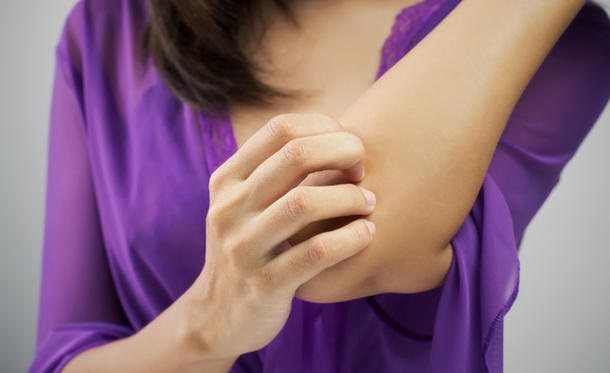
Differential diagnosis
Spots on the elbows can appear not only due to allergies, but also due to other diseases, such as:
Determining which pathology causes skin changes is very important. This will allow you to quickly take the necessary primary care measures, and secondly, understand which specialist you should contact.
Photo: Psoriasis should be distinguished from manifestations of allergies
Psoriasis is accompanied by unpleasant itching, rash and burning. As a rule, this disease most often occurs in young people under 20 years of age (about 70% of patients). Psoriasis spots are large, often occupying half of the forearm. They look like red “pools” with white crusts on top. The spots are rough to the touch, protrude above the surface of the skin, rough, rough. The appearance of rashes is not prevented by contact with the allergen; they usually appear on both hands at once.
Mycosis is a disease that is caused by parasitic fungi. In the initial stages and with a mild course of the disease, small pinkish spots appear with small elevations in the center. Manifestations of the disease may look like areas of skin “peeling” after a burn. In severe mycosis, the affected area of skin is disfigured.
Granulomas are an inflammation characterized by the proliferation of connective tissue cells in the form of nodules. Very often this disease affects the teeth and genitals. This pathology develops for a variety of reasons:
- tuberculosis;
- syphilis;
- tularemia;
- rabies;
- viral encephalitis
- and etc.
The appearance of granulomas is accompanied by symptoms of the corresponding disease.
To find out what is causing the rash on the skin of the elbow, you should first consult a doctor who can make an accurate diagnosis.

